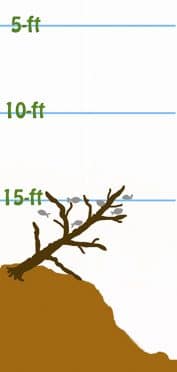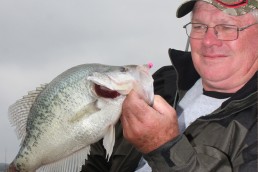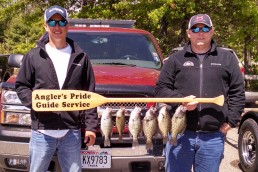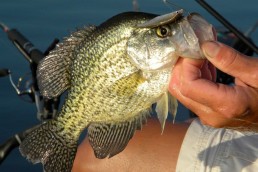Hit the Crappies on Deep Ledges
SHARE THIS POST
November and December crappies provide some of the best fishing of the year. Cooler water will move fish to deeper water and tighter groups. After locating them, it’s not too difficult catching numbers of fish. A great place to start the search is a ledge.
Step by step
Experience on a lake is a huge advantage. Knowing where to look is a big time-saver. But, even without experience, a good map will show ledges.
The next step is to use your electronics. All sonars are now good at showing depths and cover. Seeing fish and shad is a big bonus. However, marking cover and test-fishing will quickly reveal if fish are present.
Form a pattern, especially the right depth. Crappies are creatures of habit and consistency. If you catch crappies at 17 feet, you should be able to go to similar spots and catch more fish at 17 feet. Finding the zone and keeping baits in that zone is very important.
Ledges
Find a ledge, find cover and form a pattern. Note that not all ledges are created equal. Depth plays a major role, but so does the steepness or slope. A sharper drop-off is often harder and more to a crappie’s liking. Outside creek and river bends are good examples of where the bottom may be harder.
Good spots may be difficult to find, so be sure to mark them not only for the present trip but for future trips, too. Going to a waypoint is a prime example of using experience to your advantage.
Presentations
There are no guarantees in crappie fishing. A pattern today will likely be good tomorrow, but there’s no guarantee. If the same thing worked every time, everybody would catch fish all the time.

The cooler the water, the slower the presentation. That’s a general rule that usually holds true. Move a bait as slowly as you can, then slow down some more.
Are you enjoying this post?
You can be among the first to get the latest info on where to go, what to use and how to use it!
Good techniques for slow presentations include vertical jigging or casting with a slip-float. These allow a fisherman to determine the speed, which can be holding it as still as possible in the same place. With a float, waves and current are the primary factors for speed. When neither is present or very minor, a float can hold a bait in the same spot for as long as needed.
Southern and middle-states fishermen will also be slow-trolling this time of year. The boat is used to move or stop baits as needed. The advantage is, in states where allowed, multiple poles and baits can be used.
Staying on a spot on a ledge in open water can be tricky. Even with today’s electronics, a marker buoy tossed near the cover will help pinpoint where baits should be located. It’s easier to fish with a visual marker than to keep your eyes on a locator most of the time.
Sometimes the old ways are the best ways
A favorite and productive method years ago can still be productive today. A “do-nothing” long pole, rigged with an appropriate bait and placed in a holder, gives the opportunity for bonus bites while the fisherman jigs or casts. Casting is a good winter method, too, with the do-nothing pole providing bonus crappies. What to rig on the do-nothing? Try a 1/4-ounce split shot placed 15 inches above a hook and minnow.
Winter crappies are notorious for light bites. Going with the lightest line possible is a big bonus for more bites. Going with a light bait is also good. The key is to use a sensitive-tipped pole to see more bites. The same with a float. Use the smallest possible float so light bites are felt and the crappie doesn’t feel it.
The best bait can vary upon region and technique. Jigging spoons and tiny jigs are popular in the north. Middle states fishermen will likely be using small to mid-sized jigs. The type is often whatever is hot on the lake at the time. Winter, clear water colors often include black-white and blue-white, but it’s difficult to predict what crappies will want on a particular day.
Minnows are always a good bait. They are less versatile and don’t like repeated casts, but fished vertically or under a float, they work great.
Crappie fishing the last two months of the year can be fantastic. There is no one perfect place or technique, but a ledge is always a good structure to start. Find a pattern and enjoy the action.
MWO
SHARE THIS POST
Did you enjoy this post?
You can be among the first to get the latest info on where to go, what to use and how to use it!
Tim Huffman
Tim Huffman specializes in crappie fishing, is editor for two crappie magazines, as well as writing for several others. In 2018, he published his sixth book, Limiting Out for Crappie, available at Amazon. His first article appeared in MidWest Outdoors in 1988.



